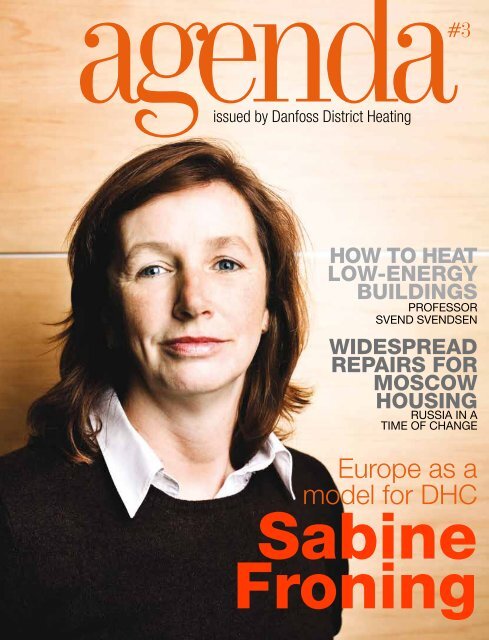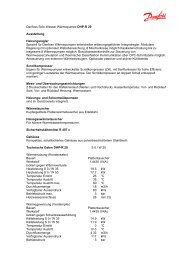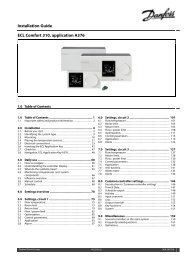Europe as a model for DHC - Danfoss.com
Europe as a model for DHC - Danfoss.com
Europe as a model for DHC - Danfoss.com
Create successful ePaper yourself
Turn your PDF publications into a flip-book with our unique Google optimized e-Paper software.
issued by <strong>Danfoss</strong> District Heating<br />
#3<br />
How to Heat<br />
low-energy #1<br />
buildingS<br />
Professor<br />
svend svendsen<br />
District heating wideSpread<br />
repairS<br />
by <strong>Danfoss</strong><br />
For<br />
MoScow<br />
HouSing<br />
russia in a<br />
time of change<br />
<strong>Europe</strong> <strong>as</strong> a<br />
<strong>model</strong> <strong>for</strong> <strong>DHC</strong><br />
Sabine<br />
Froning
26<br />
ACADEMY<br />
Professor Svend Svendsen<br />
sees district heating <strong>as</strong><br />
a natural solution <strong>for</strong> the<br />
<strong>com</strong>ing generation of<br />
low-energy buildings.
CONTENTSFEBRUARY2009<br />
06 News<br />
Tapped <strong>for</strong> <strong>Europe</strong>’s largest city<br />
expansion project, <strong>Danfoss</strong> also<br />
expands its presence in Lithuania<br />
and Poland. Big plans <strong>for</strong> the 2009<br />
United Nations Climate Change<br />
Conference in Copenhagen. <strong>Europe</strong>an<br />
Parliament climate directive includes<br />
<strong>DHC</strong>. And more.<br />
10 Q&A<br />
Sabine Froning, the managing<br />
director of Euroheat & Power,<br />
provides an international<br />
perspective on the growth of<br />
<strong>DHC</strong> and CHP. Interest in these<br />
technologies is gaining ground<br />
in many countries and <strong>Europe</strong><br />
can serve <strong>as</strong> a <strong>model</strong>.<br />
14<br />
Discussion<br />
Moscow building<br />
renovations include<br />
focus on energyefficient<br />
heating<br />
systems.<br />
Solutions<br />
Original district heating<br />
systems reconnected in<br />
Natural History Museum<br />
and four other London<br />
landmarks.<br />
22<br />
20 World<br />
According to Robert<br />
Thornton, district energy<br />
h<strong>as</strong> a long p<strong>as</strong>t and<br />
a promising future in<br />
the United States.<br />
30 Online<br />
A handy cyber-guide<br />
to help you locate<br />
useful energy-related<br />
Internet sites.<br />
agenda 3
4 agenda<br />
NEw efficiencies <strong>for</strong> Old systems<br />
Energy-efficient and nature-conscious<br />
energy systems are of global importance.<br />
The concept of simultaneously minimising<br />
carbon emissions, managing individual<br />
consumption, optimising <strong>com</strong><strong>for</strong>t and<br />
improving the overall efficiency of energy<br />
generation, supply and usage is still a relatively<br />
new one. The global <strong>com</strong>munity is<br />
very diverse in terms of its <strong>com</strong>mitment to<br />
district heating (DH) <strong>as</strong> a sustainable solution<br />
that can play a major role in future<br />
energy systems. For this re<strong>as</strong>on, sharing<br />
knowledge and experience across borders<br />
is extremely important. I am happy<br />
that this edition of Agenda is <strong>com</strong>mitted<br />
to making some headway on this front,<br />
with c<strong>as</strong>e studies and contributions from<br />
around the globe.<br />
There are some great learning opportunities<br />
available in sharing Russian DH<br />
trends and examples. In <strong>com</strong>parison to<br />
the UK and the United States, Russia h<strong>as</strong><br />
a very large DH supply. Water-b<strong>as</strong>ed DH<br />
h<strong>as</strong> a significant share of the domestic<br />
heat supply – <strong>as</strong> much <strong>as</strong> 70% – and<br />
most Russian cities were planned and<br />
developed on the understanding that DH<br />
would provide the most efficient energy<br />
system. However, during political transition<br />
throughout the nineties, the lack of<br />
continual investment and maintenance of<br />
these systems h<strong>as</strong> lead to their demise.<br />
<strong>Danfoss</strong> is in a very privileged position in<br />
Russia today, in that the ethics and benefits<br />
at the core of its solutions are totally in<br />
line with the national government’s strategy<br />
to re-inject 360 degree efficiency into<br />
the country’s DH systems. Energy loss<br />
in the distribution network is currently<br />
<strong>as</strong> high <strong>as</strong> 50% in some are<strong>as</strong>. There is<br />
also the potential of up to 30% savings to<br />
be made within many buildings with the<br />
supply and modernisation of substations,<br />
controls, balancing valves and other <strong>com</strong>ponents.<br />
The latter is low-hanging fruit if<br />
Russian DH utilities and authorities can<br />
appreciate the return-on-investment that<br />
can be achieved through energy savings<br />
by such modernisation. <strong>Danfoss</strong> is <strong>com</strong>mitted<br />
to endorsing this proposition, not<br />
only in the supply of <strong>com</strong>plete solutions<br />
<strong>for</strong> major projects, but also in sharing its<br />
knowledge with external engineers, designers<br />
and decision makers at seminars<br />
and other <strong>for</strong>ums.<br />
Trans<strong>for</strong>ming the operational efficiency<br />
of Russian DH systems also requires a<br />
certain amount of active responsibility<br />
from the end user. In Russia, like many<br />
countries around the world, DH-b<strong>as</strong>ed<br />
utilities <strong>for</strong> multi-dwelling ac<strong>com</strong>modation<br />
are me<strong>as</strong>ured and billed according<br />
to occupied space, not individual consumption.<br />
There<strong>for</strong>e, the consumer h<strong>as</strong><br />
a very low knowledge or appreciation<br />
of their personal energy consumption –<br />
thermostats are mainly understood only<br />
<strong>as</strong> a <strong>com</strong><strong>for</strong>t device and used very seldom.<br />
It is no secret that potential cost<br />
savings are a major motivator <strong>for</strong> consumers,<br />
and making it a requirement to<br />
me<strong>as</strong>ure and bill energy consumption on<br />
an individual b<strong>as</strong>is would encourage end<br />
users to streamline their usage. Until the<br />
real importance of all the dimensions of<br />
energy efficiency is fully understood by<br />
everyone, such cost-focused legislation<br />
would make a real impact in Russia, and<br />
in many other markets.<br />
Mikhail Shapiro<br />
General Manager<br />
<strong>Danfoss</strong> District Heating, Russia<br />
#3<br />
#3, 2009. <strong>Danfoss</strong> A/S: <strong>Danfoss</strong> District Heating, 6430 Nordborg, Denmark, Tel +45 7488 2222, www.dh.danfoss.<strong>com</strong>.<br />
issued by <strong>Danfoss</strong> District Heating<br />
Editor: Thom<strong>as</strong> Heide Jørgensen, thom<strong>as</strong>_heide@danfoss.<strong>com</strong>.<br />
#1<br />
Publisher: Weis & Co. ApS, Middelfartgade 17, 2100 Copenhagen Ø, Denmark, Tel +45 33 366 266, info@weis-co.dk<br />
District heating by <strong>Danfoss</strong><br />
Art Director: Anna Ax. Copywriters: Jesper With, Rob Holder, Dmitriy Shkolnikov, Paul Barfoot.<br />
Proof-reader: InterText | Mus & Pen, Malene Sejer Larsen. Paper: 100 milligram, CyclusOffset, Dalum Papir, Denmark.<br />
agenda is distributed by <strong>Danfoss</strong>. Opinions expressed in this publication are those of the authors or persons interviewed, and do not necessarily reflect the views of <strong>Danfoss</strong> or Weis & Co.<br />
All rights reserved. Material may not be reproduced in any <strong>for</strong>m without prior written permission. Unsolicited manuscripts, photographs and illustrations are not accepted. agenda accepts no<br />
responsibility <strong>for</strong> such material sent to its office, and is not liable <strong>for</strong> loss or damage of such material. agenda <strong>as</strong>sumes no responsibility <strong>for</strong> printing errors.
The <strong>Danfoss</strong><br />
headquarter<br />
in Nordborg<br />
agenda 5
News <strong>Danfoss</strong> highlights<br />
6 agenda<br />
RECoRD TEnDER SucceSS In PolAnD<br />
danfoss LPm is proud to report a tender victory of 312 substations<br />
to support the modernisation of 130 km of district heating<br />
network in the large Polish city of Krakow. it is part of an<br />
ongoing €75.4 million project, <strong>for</strong> which Krakow district heating<br />
<strong>com</strong>pany received €54.4 million in eu funding.<br />
danfoss LPm is not a stranger to the project. following successful<br />
realisation of two previous tenders in 2006 and 2007, it<br />
h<strong>as</strong> already delivered 127 substations, automatic controls and<br />
heat exchangers. together with significant exchange of applica-<br />
GRoWTH oF DAnFoSS<br />
SolUTIonS in litHuania<br />
the predominance of one-pipe centralised systems and the lack<br />
of new-build system regulations have made it difficult to mobilize<br />
energy efficiency in Lithuania.<br />
danfoss works closely with local designers, installers and investors<br />
to actively encourage the uptake of more energy-efficient<br />
solutions in this post-soviet territory, and is proud to report mea-<br />
surable success.<br />
in 2005, a pilot scheme in the gandraliskes district of Klaipeda<br />
installed danfoss substations, type akva Lux tdP in 88 domestic<br />
flats. the benefit of a 44% saving in heating tariffs helped make<br />
the advantages of a decentralised system tangible to residents<br />
and stakeholders, and sparked a wave of similar projects across<br />
the country.<br />
over the l<strong>as</strong>t two years, 700 danfoss substations, type akva Lux<br />
tdP and akva Lux tdP-f have been installed in the city of Klaipeda,<br />
<strong>as</strong> well <strong>as</strong> being implemented into all new-builds in the city of<br />
Panevezys. the same solutions will be used <strong>for</strong> a new multi-family<br />
house project that will provide 1,742 flats <strong>for</strong> 6,000 gandraliskes<br />
residents. it h<strong>as</strong> also been confirmed that danfoss substations,<br />
termix vmtd types, will be used <strong>for</strong> a major multi-family house<br />
renovation initiative in the city of Kaun<strong>as</strong> later this year.<br />
tion know-how, they have helped trans<strong>for</strong>m the efficiency and<br />
<strong>com</strong><strong>for</strong>t of the energy supply to many of the city’s residents and<br />
work<strong>for</strong>ce.<br />
however, the recent 312-unit substation order represents the<br />
<strong>com</strong>pany’s biggest to date, and strengthens danfoss’ presence<br />
in the region. so far, 188 units have been delivered out of the<br />
danfoss LPm factory in tuchom, Poland. the remaining 124<br />
substations are scheduled <strong>for</strong> production, <strong>as</strong>sembly and delivery<br />
in the first half of 2009.
DAnFoSS PREPARES<br />
For cop 15<br />
the danish capital will host the united nations climate change<br />
conference in december 2009, and danfoss preparations are<br />
underway to be an active supporter and presence.<br />
firstly, danfoss is a main sponsor of the danish climate consortium,<br />
a joint venture between the national ministry of economic<br />
and Business affairs and leading business organisations that will<br />
have a major voice at the event. the danish climate consortium<br />
is involved in a series of events and exhibition arrangements<br />
around coP 15 that will provide opportunities to interact with<br />
danish technologies that are having a positive impact on climate<br />
change, including solutions provided by the danfoss group.<br />
danfoss district heating and White Paper partners (grundfos,<br />
Logstor and coWi) have also entered arrangements <strong>for</strong> a<br />
joint exhibition booth at the Bright green eXPo in Parken, 12th-<br />
13th december (www.brightgreen.dk). it is an event organised<br />
by the confederation of danish industry (di) to bridge the two<br />
weeks of coP 15. the joint booth is an extension of the collabo-<br />
<strong>Danfoss</strong> highlights News<br />
<strong>DHC</strong> breaktHrougH<br />
In THE EURoPEAn PARlIAMEnT<br />
the joint dhc industry, including the national and european dhc<br />
<strong>as</strong>sociations plus leading industry <strong>com</strong>panies, have worked intensively<br />
during 2008 to influence the contents of the eu directive <strong>for</strong><br />
the promotion of renewable energy sources (res). it is a ple<strong>as</strong>ure to<br />
report that the collaborative ef<strong>for</strong>ts to ensure that district heating and<br />
cooling (dhc), <strong>com</strong>bined heat and power (chP) and efficient heat<br />
pump technology be featured <strong>as</strong> key res in the eu climate agreement<br />
have paid dividends.<br />
a key paragraph in the approved directive states: “member states<br />
shall re<strong>com</strong>mend to all actors, in particular local and regional administrative<br />
bodies, to ensure equipment and systems are installed <strong>for</strong> the<br />
use of heating, cooling and electricity from renewable sources and <strong>for</strong><br />
district heating and cooling when planning, designing, building and<br />
refurbishing industrial or residential are<strong>as</strong>.”<br />
this represents a milestone in elevating the status of dhc to that of<br />
wind and solar energy options, and highlights it <strong>as</strong> an important element<br />
of <strong>com</strong>bined sustainable energy solutions. the endorsement is<br />
also key to realizing the ambitious targets set <strong>for</strong> 2020, which include a<br />
20% reduction of co2 <strong>com</strong>pared to 1990 and 20% improved energy<br />
efficiency, of which 20% should be covered by res.<br />
ration initiated by the 2007 district heating/cooling White Paper,<br />
available to download from www.dh.danfoss.<strong>com</strong>/agenda.<br />
in the <strong>com</strong>ing months, danfoss will continue to explore further<br />
opportunities to provide support <strong>for</strong> coP 15, and looks <strong>for</strong>ward<br />
to meeting industry colleagues and stakeholders at events and<br />
<strong>for</strong>ums leading to this important world event in copenhagen.<br />
agenda 7
News <strong>Danfoss</strong> highlights<br />
8 agenda<br />
luxury<br />
coMFort<br />
FoR TURKISH<br />
ToWERS<br />
the selenium twins are two<br />
luxurious 34-storey residential<br />
blocks located in fulya, istanbul.<br />
they reside on a 29,000 m2 area<br />
of land owned by Besikt<strong>as</strong> JK<br />
football club that includes a<br />
ten-storey hospital building,<br />
21-storey office building and<br />
16,000 m2 supermarket.<br />
<strong>as</strong>çıoglu construction <strong>com</strong>pany<br />
had high demands <strong>for</strong> the<br />
selenium twins’ energy system.<br />
it selected danfoss to equip the<br />
facility with a solution that bo<strong>as</strong>ts<br />
low operational and investment<br />
costs, and delivers consistent<br />
high <strong>com</strong><strong>for</strong>t. a total of 222<br />
danfoss substations – type<br />
termix vmtd-f with heatmeters,<br />
motorized valves, balancing<br />
valves and pressure reducers –<br />
power the supply of heat and hot<br />
water to the domestic towers.<br />
the buildings are installed with<br />
perfect remote meter reading<br />
technology, and use m-bus<br />
data transmission protocol to<br />
obtain data from danfoss heat-<br />
meters and watermeters in order<br />
to generate a <strong>com</strong>bined utility<br />
bill <strong>for</strong> residents. B<strong>as</strong>ed on the<br />
success of the selenium twins<br />
project, <strong>as</strong>çıoglu construction<br />
<strong>com</strong>pany h<strong>as</strong> <strong>com</strong>mitted to<br />
replicate the same solution <strong>for</strong><br />
two other projects – selenium<br />
Panorama and selenium city. this<br />
will equate to an additional supply<br />
of approximately 500 danfoss<br />
termix vmtd-f substations.
DAnFoSS EqUIPS<br />
europe’S largeSt city<br />
ExPAnSIon PRojECT<br />
danfoss h<strong>as</strong> been selected to supply substations, water heaters<br />
and domestic hot water systems to equip the majority of<br />
the central heating connections in hamburg’s new quarter –<br />
hafencity.<br />
situated in the heart of hamburg, hafencity will trans<strong>for</strong>m a<br />
historic harbour area into a new live-and-work vicinity that will<br />
grow the city centre by a m<strong>as</strong>sive 40%.<br />
the two million m2 project includes <strong>com</strong>mercial new-builds<br />
that will provide 40,000 work places, and 5,500 new domestic<br />
premises that will house up to 12,000 citizens.<br />
the energy policy <strong>for</strong> hafencity is driven by sustainable principles,<br />
and a <strong>com</strong>bination of district heating, decentralized<br />
block heating plants, solar power and fuel cells will service<br />
the area.<br />
hafencity is a world-cl<strong>as</strong>s example of carbon-conscious<br />
urban growth, and danfoss is delighted that its solutions will<br />
play an integral part in this seminal city expansion project.<br />
<strong>Danfoss</strong> highlights News<br />
FlAT SUbSTATIonS AnD<br />
DECEnTRAlIzED SySTEMS<br />
Made eaSy<br />
in collaboration with Zagreb district heating <strong>com</strong>pany, the heating<br />
team from danfoss croatia announce the launch of a new<br />
practical handbook on flat stations and decentralized heating<br />
systems.<br />
the publication is part of an ongoing <strong>com</strong>mitment to provide<br />
quality in<strong>for</strong>mation, documentation and knowledge to encourage<br />
best practice standards <strong>for</strong> residential heating systems in<br />
the district heating sector.<br />
the handbook is to be an essential reference <strong>for</strong> consultants<br />
re<strong>com</strong>mending, planning and installing new heating systems, or<br />
modernizing existing installations. content includes <strong>com</strong>prehensive<br />
answers to faQs, a series of tables to simplify dimensioning<br />
and tips to guide e<strong>as</strong>ier installation.<br />
the handbook is currently available in croatian. <strong>for</strong> further<br />
in<strong>for</strong>mation, ple<strong>as</strong>e contact the danfoss office in Zagreb (email:<br />
danfoss.hr@danfoss.<strong>com</strong>).<br />
agenda 9
Spreading<br />
the word<br />
AboUT DISTRICT HEATInG AnD CoolInG<br />
Sabine Froning is the managing director of Euroheat & Power (EHP),<br />
the international <strong>as</strong>sociation <strong>for</strong> district heating and cooling, Brussels.<br />
Although her organization’s main focus is promoting district<br />
heating/cooling (<strong>DHC</strong>) and <strong>com</strong>bined heat and power (CHP) within<br />
the EU, interest in these technologies is gaining ground in many countries.<br />
She discusses how <strong>Europe</strong> can serve <strong>as</strong> a <strong>model</strong> <strong>for</strong> implementing<br />
technologies worldwide that can both benefit local economies and provide<br />
answers to energy use and climate change questions that affect us all.<br />
TExT Rob HolDER, PHoToS CHRISTIAn AlSInG<br />
Since we’re focusing today on how<br />
<strong>Europe</strong> might help drive development<br />
of district heating in other regions of<br />
the world, let’s start with a somewhat<br />
provocative question: If district heating<br />
is such a good idea, why isn’t it<br />
more widespread?<br />
Well, <strong>as</strong> a colleague of mine likes to say,<br />
one of the re<strong>as</strong>ons district heating isn’t<br />
more widespread is that it h<strong>as</strong> been sort<br />
of a well-kept secret. Even in countries<br />
like Denmark, where district heating is<br />
well established, not everyone is aware of<br />
its benefits, <strong>as</strong> the sector h<strong>as</strong>n’t really advertised<br />
its advantages very much in the<br />
p<strong>as</strong>t. beyond simple lack of awareness,<br />
there’s even active prejudice against the<br />
idea of district heating in many are<strong>as</strong>. I’m<br />
thinking now particularly of e<strong>as</strong>tern <strong>Europe</strong>an<br />
countries where district heating actually<br />
is widespread. In these countries, <strong>as</strong><br />
in Russia, district heating w<strong>as</strong> an integral<br />
part of the old Soviet infr<strong>as</strong>tructure. but<br />
people have memories of very inefficient<br />
application of district heating. They remember<br />
a kind of “all on” or “all off” heating,<br />
in which the only way to regulate heat<br />
in a room w<strong>as</strong> to open or close a window.<br />
They don’t have an idea of modern district<br />
heating <strong>as</strong> we know it, which can be e<strong>as</strong>ily<br />
Sabine Froning Q&A<br />
controlled by individuals or households.<br />
The technology w<strong>as</strong> not up to date, and<br />
the infr<strong>as</strong>tructure w<strong>as</strong> in bad shape. An<br />
International Energy Agency (IEA) study<br />
shows that refurbishing the Russian district<br />
heating system could save 60 billion<br />
cubic meters of natural g<strong>as</strong> a year, which<br />
b<strong>as</strong>ically corresponds to the total g<strong>as</strong><br />
consumption of Germany. In the new EU<br />
member states, a lot of progress h<strong>as</strong> already<br />
been made over the p<strong>as</strong>t decade,<br />
but there’s still a huge need <strong>for</strong> further<br />
investments. So even in are<strong>as</strong> where<br />
district heating already exists, there’s<br />
plenty of work to be done.<br />
agenda 11
Q&A Sabine Froning<br />
12 agenda<br />
“It’s be<strong>com</strong>ing widely understood that we can’t af<strong>for</strong>d to<br />
continue using more and more fossil fuels, both <strong>for</strong> environmental<br />
re<strong>as</strong>ons and simply because there are limited resources.<br />
district heating and cooling must inevitably be part of the solution<br />
worldwide because it brings efficiency to the whole energy system.”<br />
What is the level of interest in other<br />
regions of the world -– outside the<br />
EU – and what drives that interest?<br />
We find there’s tremendous interest in<br />
district heating in other countries – not<br />
just on this continent but also in countries<br />
such <strong>as</strong> China, South Korea and<br />
japan, where growth rates have been<br />
very good over the p<strong>as</strong>t ten years.<br />
Interest is driven in large part by concern<br />
over security of g<strong>as</strong> supplies and climate<br />
change. We recently hosted a large de-<br />
legation from representatives of district<br />
heating <strong>com</strong>panies in japan, and<br />
they were chiefly interested in how we<br />
handle the environmental question.<br />
These two issues – environmental<br />
concerns and fuel suply security – are<br />
the main drivers behind the growth of<br />
district heating in most countries.<br />
The fundamental idea behind modern<br />
district heating is to make use of heat<br />
that would otherwise be w<strong>as</strong>ted, <strong>for</strong><br />
example when electricity is generated<br />
or w<strong>as</strong>te is burned – which are fundamental<br />
urban functions everywhere. All<br />
kind of renewable sources like biom<strong>as</strong>s,<br />
geothermal, solar thermal and others<br />
can also contribute. I think that one<br />
re<strong>as</strong>on the northern <strong>Europe</strong>an countries<br />
have taken the lead in these are<strong>as</strong> is that<br />
the tradition of collective thinking and<br />
decision-making – which district heating<br />
demands – is rooted in the thinking here.<br />
District heating used to be not so widespread<br />
in the UK, <strong>for</strong> example, where<br />
everything is more individualized. but<br />
today there is a growing awareness that<br />
energy use needs to be more efficient<br />
in all parts of the world. It’s be<strong>com</strong>ing<br />
widely understood that we can’t af<strong>for</strong>d<br />
to continue using more and more fossil<br />
fuels, both <strong>for</strong> environmental re<strong>as</strong>ons<br />
and simply because there are limited<br />
resources. District heating must inevitably<br />
be part of the solution worldwide<br />
because it brings efficiency to the whole<br />
energy system.<br />
Are you optimistic about progress in the<br />
near future, and what are some of the<br />
obstacles that district heating faces?<br />
In fact I am quite optimistic – not le<strong>as</strong>t<br />
because the IEA h<strong>as</strong> launched an inter-<br />
national initiative on <strong>DHC</strong> <strong>as</strong> well <strong>as</strong><br />
<strong>com</strong>bined heat and power (CHP). Even<br />
more positive, is the fact that the IEA w<strong>as</strong><br />
acting in response to a mandate from the<br />
G8 to make re<strong>com</strong>mendations on how to<br />
integrate these energy me<strong>as</strong>ures.<br />
The most b<strong>as</strong>ic obstacle to development<br />
is that district heating is a longterm<br />
investment, and free markets can<br />
encourage short-term focus. The current<br />
financial crisis might also make it<br />
more difficult to obtain loans <strong>for</strong> larger<br />
projects. nevertheless, it would be<br />
short-sighted to slow down investment<br />
in energy efficiency, even in countries<br />
suffering the tightest financial pinch. In<br />
the long run, it’s a fact that replacing primary<br />
fuel purch<strong>as</strong>es with domestic district<br />
heating and cooling and CHP infra-<br />
structure leads to a stronger domestic<br />
economy and lower fuel imports. of<br />
course, from country to country there<br />
are various other obstacles to district<br />
heating growth. For example in countries<br />
where the government h<strong>as</strong> a stake in oil<br />
and g<strong>as</strong> <strong>com</strong>panies, there can be an unbalanced<br />
subsidisation of oil and g<strong>as</strong>.<br />
The biggest universal political barrier I see<br />
is fragmentation of energy policy. Policies<br />
tend to be focused narrowly on a single<br />
segment of the energy landscape, targeting<br />
demand pressures, <strong>for</strong> example, but<br />
ignoring the supply sector, or on renew-<br />
ables but not on energy efficiency. This<br />
also often makes it hard to find someone
who is politically responsible <strong>for</strong> securing<br />
coherence and system optimisation<br />
from a primary energy perspective.<br />
Ideally countries should have a more<br />
horizontal, integrated political structure<br />
<strong>for</strong> dealing with energy questions. With a<br />
more <strong>com</strong>prehensive political approach,<br />
district heating and cooling will emerge<br />
<strong>as</strong> obvious solutions.<br />
Are there particular initiatives<br />
your organization is taking to spread<br />
the idea of district heat to regions<br />
beyond the EU countries?<br />
We have only five people on staff in our<br />
office, so our focus is largely on the EU.<br />
Especially now, the enormous acceleration<br />
of energy policy focus in brussels<br />
requires all our attention. but we<br />
do see the value of wider international<br />
collaboration. In fact, <strong>as</strong> I mentioned<br />
earlier, we have active contact with our<br />
non-EU <strong>as</strong>sociate members – typically<br />
representatives of district heating <strong>com</strong>panies<br />
– in Russia, South Korea and<br />
japan. We’re able to help them answer<br />
questions such <strong>as</strong> how <strong>Europe</strong> structures<br />
a balance between energy and<br />
environmental quality and how district<br />
heating is treated under the emissions<br />
trading scheme. They can use what’s<br />
happening in the EU <strong>as</strong> a <strong>model</strong> to<br />
Sabine Froning Q&A<br />
help shape their own decision-making<br />
and lobbying work. I should also point<br />
out that the EU h<strong>as</strong> a strong interest in<br />
<strong>DHC</strong> and CHP growth in other are<strong>as</strong><br />
because of our ability to export these<br />
technologies – if the EU wants to be<br />
seen <strong>as</strong> a leader in energy technology,<br />
DH h<strong>as</strong> to be part of the mix.<br />
As <strong>for</strong> specific initiatives, just ahead<br />
of the 2009 United nations Climate<br />
Change Conference in Copenhagen<br />
we’re organizing a district heating<br />
summit “The Road to Copenhagen”. It<br />
will take place on 3 november and will<br />
include policy makers from all levels,<br />
national to municipal, from all around<br />
the world. We in EHP are also involved<br />
in a similar congress next May in Venice,<br />
which will also attract worldwide<br />
participants, and which will include<br />
awards <strong>for</strong> the most innovative district<br />
heating projects submitted by municipalities.<br />
both inside and outside the<br />
EU, we’re making an ef<strong>for</strong>t to emph<strong>as</strong>ize<br />
the big message: that in the long<br />
term district heating – and cooling –<br />
offers the prospect of zero-carbon<br />
heat supply. District heating already<br />
provides low-carbon heat supply, but<br />
in view of the huge amount of w<strong>as</strong>te<br />
heat now available we should <strong>as</strong>k ourselves<br />
why it’s necessary to burn any<br />
fuel specifically <strong>for</strong> heating and cooling.<br />
A strong proactive district heating<br />
policy – together with further technological<br />
advances and in <strong>com</strong>bination<br />
with renewable energy policies <strong>for</strong><br />
are<strong>as</strong> where district heating can’t be<br />
made available – holds the very real<br />
possibility of ph<strong>as</strong>ing out oil and g<strong>as</strong><br />
heating. When you raise this possibility,<br />
people listen.<br />
agenda 13
DIsCUssION Konstantin Gennadievich belchatov<br />
14 agenda<br />
Moscow in a<br />
time of change<br />
A move to <strong>as</strong>sign the property rights of<br />
residential heating units to their inhabitants<br />
is spurring huge changes in the Russian<br />
housing market. This in turn is providing<br />
new impetus to the development of the<br />
Russian heating supply market. Moscow,<br />
the capital city, is one of the largest national<br />
“building sites”. Konstantin Gennadievich<br />
Belchatov, deputy director of the<br />
Office of Capital Repairs and Construction<br />
of the Department of Housing and<br />
Community Services of Moscow (UKRiS),<br />
answers our questions about the<br />
programme and its prospects.<br />
TExT DMITRIy SHKolnIKoV, Rob HolDER<br />
PHoToS MASHKoV yURI,<br />
CoURTESy oF GUP UKRIS<br />
AnD DAnFoSS RUSSIA
DIsCUssION Konstantin Gennadievich belchatov<br />
16 agenda<br />
“In the Central Administrative district<br />
of Moscow only 5-6 buildings a year –<br />
and sometimes fewer – were repaired.<br />
The same kind of work is being<br />
conducted today, but, <strong>as</strong> I mentioned<br />
earlier, its volume is quite different,<br />
<strong>as</strong> is the management system required<br />
<strong>for</strong> effective coordination.“<br />
The current programme of <strong>com</strong>plex capital repairs in<br />
Moscow is unprecedented in its size. How do these<br />
me<strong>as</strong>ures <strong>com</strong>pare with previous ef<strong>for</strong>ts, undertaken<br />
be<strong>for</strong>e 2008, in both type and volume of work?<br />
We have a good saying: “moscow w<strong>as</strong>n’t built in a day”.<br />
actually, in such a big city there are always structures in<br />
need of repair. But now a <strong>com</strong>plex modernization plan h<strong>as</strong><br />
been p<strong>as</strong>sed that affects all housing stock up to 2014. it is<br />
connected primarily to the re<strong>for</strong>m of housing and <strong>com</strong>munity<br />
dwellings being undertaken throughout the country.<br />
Be<strong>for</strong>e being signed over to their owners, buildings have<br />
to be put in good condition. of course, capital repairs of<br />
residential buildings were also conducted be<strong>for</strong>e 2008. the<br />
moscow government programme of scheduled preventive<br />
maintenance w<strong>as</strong> carried out within the city and included<br />
the replacement of heating systems, hot and cold water<br />
supply, and other repairs. Both the scale and financing of<br />
that work w<strong>as</strong> several times smaller than what’s being undertaken<br />
today. <strong>for</strong> example, in the central administrative<br />
district of moscow only 5-6 buildings a year – and sometimes<br />
fewer – were repaired.<br />
the same kind of work is being conducted today, but, <strong>as</strong><br />
i mentioned earlier, its volume is quite different, <strong>as</strong> is the<br />
management system required <strong>for</strong> effective coordination.<br />
in fact, an entirely new administrative system w<strong>as</strong> established<br />
under the direction of Petr Biryukov, the first deputy<br />
mayor. since the beginning of 2008, there have already<br />
been repairs to 63 residential buildings with a total area<br />
of 508.9 sq. meters. repairs were also made to 92 blocks<br />
of flats, including facades with outer wall insulation, replacement<br />
of window and balcony pulleys and glazing of<br />
balconies. on the whole, capital repairs were conducted in<br />
1,697 residential buildings in the city.<br />
What are the factors influencing the progress of the<br />
repair work? Are there specific difficulties?<br />
the most important factors are the experience of the contractors<br />
and the level of their staff qualifications. i mean<br />
not only technical background but also teamwork and experience.<br />
in any one building, success depends mostly on<br />
the contractor’s skill in finding a <strong>com</strong>mon language with<br />
the building’s inhabitants. if they understand and agree<br />
with each other, the work will go smoothly. <strong>as</strong> the city consists<br />
of many individual addresses, this is the keystone
Konstantin<br />
Gennadievich Belchatov<br />
A 1991 graduate of Kaliningrad Technical College,<br />
Konstantin Gennadievich Belchatov lives in Pushkino,<br />
Moscow Region. In 1994, after having served in the army,<br />
he entered Moscow State Forest University and obtained an<br />
engineering degree. In 2004 Mr. Belchatov w<strong>as</strong> appointed<br />
to the post of lead engineer <strong>for</strong> support of the municipal<br />
infr<strong>as</strong>tructure in the Central Administrative District of<br />
Moscow. In 2005 he w<strong>as</strong> transferred to the Moscow Board<br />
of Capital Repairs and Construction (GUP UKRiS), taking the<br />
position of deputy chief manager in the Engineering Supervision<br />
Department. In March 2008, he w<strong>as</strong> appointed to the<br />
post of acting director of GUP UKRiS, and later in 2008 he<br />
w<strong>as</strong> appointed <strong>as</strong> a director of GUP UKRiS. Mr. Belchatov<br />
h<strong>as</strong> a wife and two children.<br />
of success. <strong>as</strong> <strong>for</strong> difficulties, they are inseparably <strong>as</strong>sociated<br />
with the <strong>com</strong>munication issue i just mentioned. the<br />
only real obstacle that can be a barrier to the success of<br />
the programme is antagonism between owners and contractors,<br />
since you can’t get admission to a flat if its inhabitants<br />
hinder it. if this happens, it’s not possible to do<br />
certain repairs, which leads to breakdown of repair ef<strong>for</strong>ts.<br />
it is all interrelated. currently, i don’t find other problems<br />
deriving directly from our work. to settle conflicts that do<br />
arise, we’ve created an executive staff <strong>for</strong> checking capital<br />
repair fulfillment in every district. if difficulties occur, they<br />
are solved in real time.<br />
Are contractors generally conscientious in<br />
<strong>com</strong>pleting projects <strong>as</strong> specified? How is their<br />
per<strong>for</strong>mance monitored?<br />
of course they’re conscientious – otherwise they don’t receive<br />
payment! material incentives clearly work. contractors<br />
are paid only if everything is <strong>com</strong>pleted within the framework<br />
of the project specifications and quality requirements.<br />
this is determined through an acceptance report from the<br />
state <strong>com</strong>mittee. approval evaluations are per<strong>for</strong>med in<br />
Konstantin Gennadievich belchatov DIsCUssION<br />
agenda 17
DIsCUssION Konstantin Gennadievich belchatov<br />
18 agenda<br />
“Of course rooms<br />
should be ventilated,<br />
but unlike the old<br />
days there’ll be<br />
strong economic<br />
re<strong>as</strong>ons against<br />
senseless heating<br />
of the street.”<br />
<strong>com</strong>pliance with the existing regulatory system, including a<br />
<strong>for</strong>mal report b<strong>as</strong>ed on tests – in particular a pressure test<br />
of the heating system. also various other project solutions<br />
are checked. moreover, warranty work is the responsibility<br />
of the contractors. if violations are detected, they have to<br />
<strong>com</strong>e back and do the work again.<br />
In your opinion, how much do Moscow citizens know<br />
about the 2008-2014 capital repair programme?<br />
this varies from person to person. socially active citizens<br />
interested in the capital repair process are well in<strong>for</strong>med<br />
about the programme. experience shows that there are a<br />
lot of people who are interested in our initiatives. many apply<br />
with requests about including their houses in the work<br />
plan. in this regard, there is an active interaction between<br />
city residents and municipal organizations. of course,<br />
some people who don’t read newspapers or watch tv be<strong>com</strong>e<br />
aware of the programme only at the moment when<br />
the contractors ring the doorbell.<br />
What about energy-saving equipment and its benefits<br />
<strong>for</strong> both energy <strong>com</strong>panies and building residents?<br />
there is no doubt that energy providers are interested in the<br />
capital repair process, because it’s much e<strong>as</strong>ier to service<br />
the new equipment. in addition, new energy application technologies<br />
– such <strong>as</strong> <strong>com</strong>munication solutions <strong>for</strong> heating sy-<br />
stems that enable remote monitoring and control – make their<br />
jobs e<strong>as</strong>ier. in my opinion, benefits <strong>for</strong> residents are obvious.<br />
energy saving is important <strong>for</strong> them because the final target<br />
of the housing and <strong>com</strong>munity building re<strong>for</strong>m programme<br />
is the full <strong>as</strong>signment of property ownership to residents.<br />
once they <strong>as</strong>sume ownership, residents will be responsible<br />
<strong>for</strong> water, heating and electricity payments. that’s why the<br />
energy-saving me<strong>as</strong>ures carried out within this programme<br />
will be<strong>com</strong>e a very important economic factor.<br />
equipment choice h<strong>as</strong> to be carefully considered, from<br />
water and electricity meters to heating automation – including<br />
danfoss thermostats, which are installed in heating<br />
systems within the framework of the programme. after<br />
the modernization process is finished, building residents<br />
will be able to control the microclimate in their own flats.<br />
When people pay <strong>for</strong> heating according to actual energy<br />
consumption, they’ll consider whether it’s better to set the<br />
radiator thermostat to a lower temperature or to open a<br />
window. of course rooms should be ventilated, but unlike
the old days there’ll be strong economic re<strong>as</strong>ons against<br />
senseless heating of the street.<br />
But this system is not yet widespread –<br />
are citizens beginning to understand and accept it?<br />
i think that gradually there will be acceptance of solutions<br />
that allow individual heat billing. especially <strong>as</strong> all residents<br />
<strong>com</strong>e to understand how much heating energy they consume<br />
and how much is necessary to pay <strong>for</strong> it.<br />
What is the projected energy gain of the capital<br />
repair programme?<br />
according to project calculations, average household heating<br />
efficiency should incre<strong>as</strong>e by 30%. currently, the programme<br />
is in its initial stages. When this year’s heating se<strong>as</strong>on<br />
ends, we will be able to evaluate real heat consumption<br />
and <strong>com</strong>pare it with the preceding year. only then we can<br />
speak about the results. But undoubtedly there is potential.<br />
Can you explain a bit more about system-wide<br />
energy-saving me<strong>as</strong>ures included in the capital<br />
repair programme?<br />
Plans <strong>for</strong> heating system modernization include the instal-<br />
Konstantin Gennadievich belchatov DIsCUssION<br />
A system of pipes distributes<br />
heating to individual apartments.<br />
Since the beginning of the 2008,<br />
there have repairs to residential<br />
buildings and blocks of flats<br />
throughout Moscow. Next year<br />
the plan is to conduct capital<br />
repairs in 534 buildings.<br />
lation of substations <strong>for</strong> heating and domestic hot water,<br />
automatic balancing valves and heat meters, <strong>as</strong> well <strong>as</strong><br />
radiator thermostats <strong>for</strong> room heating in flats. Within individual<br />
buildings we’re seeing to the insulation of facades and<br />
walls, installation of modern triple-pane windows with Pvc<br />
frames and gl<strong>as</strong>sed-in balconies, along with additional insulation<br />
of the roof and b<strong>as</strong>ement floor. all these me<strong>as</strong>ures<br />
reduce heat loss and incre<strong>as</strong>e energy-savings. other<br />
government departments, such <strong>as</strong> the department <strong>for</strong> fuel<br />
and energy economy and the department <strong>for</strong> housing<br />
and <strong>com</strong>munity services, are also involved in producing<br />
energy-saving solutions.<br />
What is the outlook <strong>for</strong> the capital repair<br />
programme in 2009?<br />
next year we’re planning to conduct capital repairs in 534<br />
buildings, including work on facade insulation, window<br />
c<strong>as</strong>es and engineering services replacement.<br />
Finally, what is the impact of the financial crisis on<br />
the progress of the capital repair programme?<br />
at the moment, the financial crisis h<strong>as</strong> had no effect on<br />
either current work or future planning.<br />
agenda 19
wORLD The United States<br />
20 agenda<br />
Back to the future<br />
Robert Thornton, US, is president<br />
of the International district Energy<br />
Association (IdEA), a nonprofit<br />
industry <strong>as</strong>sociation founded in<br />
1909. Its vision is to promote<br />
energy efficiency and environmental<br />
quality through the advancement<br />
of district heating, district cooling<br />
and cogeneration. In the following<br />
article, Mr. Thornton provides<br />
wide-ranging observations about<br />
district energy/heating – its history<br />
and potential <strong>for</strong> future growth –<br />
in the United States.<br />
TExT Rob HolDER, PHoToS CoURTESy oF IDEA<br />
Robert Thornton, US, is president of the International<br />
District Energy Association (IDEA), a nonprofit<br />
industry <strong>as</strong>sociation founded in 1909. Its vision is to<br />
promote energy efficiency and environmental quality<br />
through the advancement of district heating, district<br />
cooling and cogeneration. In the following article, Mr.<br />
Thornton provides wide-ranging observations about<br />
district energy/heating – its history and potential <strong>for</strong><br />
future growth – in the United States.<br />
When Robert Thornton w<strong>as</strong> introduced recently<br />
to a prominent energy expert from M<strong>as</strong>sachusetts<br />
Institute of Technology (MIT), the man’s opening remark<br />
w<strong>as</strong>: “Ah, district energy – back to the future.”<br />
His meaning quickly be<strong>com</strong>es clear when you<br />
consider that next year IDEA celebrates its 100 th<br />
anniversary. In fact, district heating/cooling (<strong>DHC</strong>)<br />
and cogeneration in the United States are simultaneously<br />
ide<strong>as</strong> whose time h<strong>as</strong> <strong>com</strong>e and proven<br />
concepts with a long history all across the nation.<br />
The first <strong>com</strong>mercially successful district heating<br />
system w<strong>as</strong> launched in lockport, new york, in<br />
1877 by American hydraulic engineer birdsill Holly,<br />
considered the founder of district heating. Much<br />
farther west, Denver, Colorado, bo<strong>as</strong>ts a district<br />
heating system that dates back to 1880. between
and beyond these two locations, the country is dotted with<br />
district energy facilities in all 50 states. Hundreds were built on<br />
university and college campuses, which originally constructed<br />
their own powerhouses to provide heat and power at a time<br />
be<strong>for</strong>e investor-owned electric utilities were available to<br />
supply power from an electricity grid.<br />
A tIppIng poInt<br />
“In this country, district energy and <strong>com</strong>bined heat and power<br />
(CHP) are not new ide<strong>as</strong> at all,” says Thornton. “What is new<br />
is the incre<strong>as</strong>ingly widespread recognition that it’s vitally important<br />
to get all the value we can out of our fuel by harvesting<br />
heat efficiently and effectively, which also lets us reduce emissions.<br />
I think there’s been a tipping point within the l<strong>as</strong>t 18<br />
months or so – especially <strong>as</strong> people have been whipsawed<br />
by unpredictable oil prices – and a growing awareness that<br />
greener energy is in everyone’s best interest. Al Gore deserves<br />
much of credit, but many voices are echoing the need<br />
<strong>for</strong> change.” The U.S. h<strong>as</strong> a solid historical foundation to build<br />
on. District energy h<strong>as</strong> successfully delivered real benefits in<br />
terms of capital efficiency, space efficiency and – especially –<br />
reliability. District energy systems are often hidden <strong>as</strong>sets, but<br />
they deliver value around the clock, not just when the wind<br />
blows or when the sun shines.<br />
“We’re working hard to build recognition and visibility,” Thornton<br />
says. “I’ve briefed Senators, Representatives, Cabinet<br />
members and President bush – and when you have just a<br />
few minutes to explain how it all works, they invariably say,<br />
‘Wow – that makes a lot of sense.’ I believe that ours is an<br />
industry whose time h<strong>as</strong> <strong>com</strong>e around again. We face a <strong>com</strong>bination<br />
of challenges – both energy costs and the threat of<br />
climate change – and <strong>DHC</strong>/CHP can deliver on both. Many<br />
economists and policy leaders in the U.S. are looking to the<br />
clean energy industry to help drive new job growth and lead<br />
the economic turnaround <strong>as</strong> well <strong>as</strong> cut our dependency on<br />
fossil fuels and improve our negative trade balance. President<br />
obama h<strong>as</strong> cited investment in clean energy <strong>as</strong> his top priority<br />
to spur the economy.”<br />
REAdy to dElIvER<br />
<strong>DHC</strong>/CHP h<strong>as</strong> a great advantage in being a proven techno-<br />
logy, not an R&D activity. “We can deliver tomorrow,” Thornton<br />
says, “and within the new President’s first term achieve<br />
significant benefits in terms of new green jobs, and emissions<br />
and cost reductions.” The time is right to press <strong>for</strong> more collaborative<br />
solutions. Especially <strong>as</strong> in December 2007 IDEA<br />
advocated <strong>for</strong> legislation within the Sustainable Energy<br />
Infr<strong>as</strong>tructure Act, which w<strong>as</strong> signed by the President and<br />
allocated 3.5 billion dollars over five years to support design,<br />
construction and development of clean district energy and<br />
<strong>com</strong>bined heat and power. The funding, although authorized,<br />
h<strong>as</strong> not yet been appropriated. one of the principal goals of<br />
The United States wORLD<br />
IDEA in early 2009 is to lobby <strong>for</strong> the appropriation of these<br />
funds <strong>as</strong> part of an economic stimulus bill.<br />
These transitions aren’t e<strong>as</strong>y,” says Thornton. “There’s a keen<br />
interest in prudent energy decisions, but we need to have the<br />
political will to capitalize on that interest. We see IDEA’s 100 th<br />
anniversary conference in W<strong>as</strong>hington, D.C., in june 2009<br />
<strong>as</strong> an educational opportunity to show near-term solutions<br />
and how we can deliver higher fuel efficiency and emissions<br />
reductions immediately.” As more and more people see that<br />
it’s not an either-or decision between the environment and<br />
economics – that clean energy and <strong>DHC</strong> can provide a substantial<br />
return on investment – there are new funds appearing<br />
in search of re<strong>as</strong>onable-risk energy investment.<br />
tHe power oF a good idea<br />
“After all,” he points out, “development of downtown district<br />
energy in the U.S. h<strong>as</strong> largely been driven by the private sector.<br />
Since 1990 we’ve seen more than 40 new district cooling systems<br />
in north America – mainly through private sector capital<br />
investment – and there’s opportunity <strong>for</strong> more private-public<br />
partnership <strong>for</strong> new <strong>com</strong>munity-b<strong>as</strong>ed systems.” He also notes<br />
that real market gains will also require some structural changes<br />
in regulations, such <strong>as</strong> district energy/CHP qualifying in state<br />
energy efficiency portfolio standards and thermal energy gaining<br />
equal standing with electricity technologies.<br />
“We don’t have the influence of the coal, oil and electric industries,”<br />
Thornton says, “but there’s nothing like the power of a<br />
good idea to focus people’s attention. We have the benefits of<br />
solid arguments and a proven track record. And IDEA is working<br />
together with the International Energy Agency, Euroheat and<br />
Power and other <strong>as</strong>sociations around the world. We’re learning<br />
much from the EU and northern <strong>Europe</strong>an experience and<br />
bringing that in<strong>for</strong>mation <strong>for</strong>ward to our own policy makers. In<br />
the near term we may see the current financial crisis impact<br />
this market. In the long term, we need a robust cap-and-trade<br />
system, and I believe it’s <strong>com</strong>ing in the U.S.”<br />
IDEA h<strong>as</strong> begun working on improving<br />
recognition of district energy benefits to end-users such <strong>as</strong><br />
<strong>com</strong>mercial office buildings and other urban consumers. Currently,<br />
“agency” arrangements like fee-b<strong>as</strong>ed property management<br />
or <strong>com</strong>plicated <strong>model</strong>ling guidelines, such <strong>as</strong> LEED®, seem to either<br />
overlook or pinch off some of the value delivered by highly reliable<br />
steam, hot-water and chilled-water services. IDEA h<strong>as</strong> opened a<br />
dialogue with the U.S. Green Buildings Council and the Environmental<br />
Protection Agency (EPA) to address procedural changes, but must<br />
engage with multiple process stakeholders to more fully understand<br />
market dynamics and offer input to solutions.<br />
agenda 21
22 agenda
Micro network sOLUTIONs<br />
How to bring back<br />
Queen Victoria’s<br />
buildings<br />
to low carbon emissions<br />
The reinstalling of district heating at five energy-gorging old public<br />
institutions in central London means a return to the original effective<br />
way of heating.<br />
TExT jESPER WITH, PHoToS AnnA KARI<br />
A huge dinosaur in its original size is facing us <strong>as</strong> we enter the<br />
impressive main hall of the natural History Museum (nHM)<br />
in central london. Here you will find one of the world’s largest<br />
and most important collections of natural history. built in<br />
1881 in the reign of queen Victoria, the main building is one<br />
of the finest examples of 19 th -century architecture. It is full of<br />
phenomenal details like handmade terracotta tiles and w<strong>as</strong><br />
constructed in such a way that the ventilation functioned natu-<br />
rally <strong>for</strong> much of the time. The necessary heating came from<br />
a local district steam heating system, which w<strong>as</strong> installed at<br />
nHM – <strong>as</strong> it w<strong>as</strong> in four other public buildings, situated close<br />
to each other in “Albertopolis” in the South Kensington area.<br />
DIsTrICT HeATIng For 100 yeArs<br />
“later the natural ventilation system w<strong>as</strong> destroyed by bombs<br />
in the 2 nd World War, by the installation of g<strong>as</strong> fired boilers<br />
and by the installation of air conditioning, which didn’t fit<br />
the construction of the building. That w<strong>as</strong> not well thought<br />
through, since it destroyed the effectiveness of the natural<br />
ventilation systems,” Simon Tilleard explains. He works <strong>for</strong><br />
the london Climate Change Agency (lCCA), but be<strong>for</strong>e that<br />
he w<strong>as</strong> chief engineer <strong>for</strong> several years here at nHM, so he<br />
The total CO2 emissions of the Natural History<br />
Museum and its four partner institutions are<br />
58,000 tons per year. The project team believe<br />
this can be cut by half within a few years if the<br />
m<strong>as</strong>ter plan is implemented.<br />
agenda 23
sOLUTIONs Micro network<br />
24 agenda<br />
h<strong>as</strong> deep insight into the building’s construction.<br />
In the 1950’s a large-scale 42 MW district heating system<br />
w<strong>as</strong> installed in the five institutions to replace all the smaller<br />
DH systems, and this operated until 2000 when two of the<br />
institutions withdrew. “Since there w<strong>as</strong> district heating here<br />
<strong>for</strong> more than 100 years, it is actually nothing new <strong>for</strong> us to<br />
reconnect these five old buildings – three of them from Victorian<br />
times – into one micro DH network system,” Simon Tilleard<br />
says. The project, supported by the lCCA, once again involves<br />
the five institutions - the natural History Museum, the<br />
Science Museum, the Victoria & Albert Museum (V&A), the<br />
Royal Albert Hall and the Imperial College (a university). Work<br />
is going on in each organisation to implement an energy sy-<br />
stem <strong>model</strong>, which will demonstrate the leadership of the institutions<br />
and the city administration and give an overview of<br />
energy use.<br />
A Blue WHAle<br />
We p<strong>as</strong>s a blue whale, which is so huge that it fills out almost<br />
one whole gallery alone. The 69 million specimen at the<br />
museum demand the strict control of heating and cooling<br />
in order to ensure their preservation <strong>for</strong> the future. Simon<br />
Tilleard takes us from the main building to the boiler house,<br />
where a new 1.8 MW CHP w<strong>as</strong> installed l<strong>as</strong>t summer. It is<br />
placed next to two 9 MW g<strong>as</strong>-fired boilers, which are taking<br />
Simon<br />
Tilleard of the<br />
London Climate<br />
Change Agency<br />
and <strong>for</strong>mer<br />
chief engineer<br />
at the Natural<br />
History<br />
Museum.<br />
care of the daily heat supply. nHM uses 3 MW of electricity<br />
during the day, 1.5 MW at night. The CHP covers the needs<br />
of nHM in the summertime, and the surplus heat from producing<br />
electricity is used <strong>for</strong> the cooling system. This makes<br />
things much more efficient.<br />
“In 2006 it w<strong>as</strong> then refurbished with the CHP and we estab-<br />
lished an absorption refrigeration machine <strong>as</strong> well to turn<br />
surplus heat into cooling during summer. The knowledge<br />
of Danish experts w<strong>as</strong> used in this process,” Simon Tilleard<br />
says. The V&A, one of the world’s greatest museums of art<br />
and design, is just next to nHM at Exhibition Road and is<br />
connected to the same boiler house.<br />
A CoMMon MAsTer plAn<br />
Implementing an energy system <strong>model</strong> <strong>for</strong> the five public<br />
buildings w<strong>as</strong> financed by a 3 million pound grant from the<br />
Tre<strong>as</strong>ury, and the project h<strong>as</strong> resulted in a partnership of the<br />
institutions that is determined to reduce the carbon emissions<br />
from the estate.<br />
To cover electricity and heat the nHM alone would need a<br />
9 MW CHP. This h<strong>as</strong>n’t been possible, according to Tilleard<br />
because it wouldn’t be possible to sell surplus electricity <strong>for</strong><br />
a re<strong>as</strong>onable price on the market. “So it could have been<br />
better, but still, <strong>as</strong> a result of this project of nHM and V&A<br />
alone we save 2,000 tons of Co2 per year. It is quite a big<br />
step,” Simon Tilleard says. The overall idea is to develop a<br />
m<strong>as</strong>ter plan <strong>for</strong> the five institutions, which can be used at<br />
other places. Estimates indicate that 50% of the energy used<br />
can be saved, where 7 % alone <strong>com</strong>es from metering me<strong>as</strong>ures.<br />
4 % should <strong>com</strong>e from behavioural changes from staff,<br />
including the daily energy-system management.<br />
WHere Do We loose IT?<br />
Down in the boiler house Simon Tilleard shows us the pipeline,<br />
which leads to the Imperial College. or to be specific:<br />
the end of the pipeline, since the connection to the college<br />
is simply cut off. Instead Imperial College uses its own boilers.<br />
The university is spread over 300,000 square meters and<br />
is a huge energy user. Its leadership doesn’t know where<br />
exactly the energy is being used, since there are no energy<br />
meters in the different buildings. The same problem exists in<br />
the Victorian buildings, and this h<strong>as</strong> lead to a new project to<br />
install an extensive network of energy meters in all necessary<br />
places. The data gathered by these meters will make an important<br />
contribution to the overall energy-system <strong>model</strong> and<br />
the plans to reconnect all five buildings into one micro DH<br />
network system connected to a CHP and other renewable<br />
technologies. This will be a most effective way to save the<br />
city of london huge amounts of Co2 emissions every year.
what is the purpose of london eSco?<br />
The ESCo is a joint venture between london Climate Change<br />
Agency and EDF Energy, a French energy utility with more<br />
than 5 million customers in the UK. The lCCA is owned by<br />
the london Development Agency (lDA) and w<strong>as</strong> set up in<br />
2006 to introduce me<strong>as</strong>ures to reduce Co2 emissions. The<br />
london ESCo designs, builds, finances and operates Co2<br />
schemes that deliver sustainable solutions.<br />
How will london reduce its co2 emissions?<br />
The new mayor, boris johnson, puts a lot of ef<strong>for</strong>t into bringing<br />
down Co2 emissions in london. The city currently uses<br />
4 GW of electricity per year, which leads to 34 million tons of<br />
carbon emissions. The Climate Change Action Plan promotes<br />
de-carbonization of london’s electricity supply by moving<br />
move 25% of it away from the grid by 2025 and proposes<br />
instead to produce it locally, utilising CHP facilities in order<br />
to improve energy efficiency. That initiative alone will save us<br />
approximately 2.5 million tons of Co2 per year.<br />
why do you focus on decentralized energy supply?<br />
Decentralized Energy is a central point in achieving reductions<br />
in Co2 emissions. london’s existing building stock is responsible<br />
<strong>for</strong> a large part of these emissions and we actually know<br />
how to reduce emissions by supplying energy to buildings<br />
efficiently. CHP systems supply heating <strong>as</strong> well <strong>as</strong> electricity<br />
to its customers, and when required they also provide cooling<br />
(CCHP systems) – thus improving substantially the generation<br />
and delivery of energy and also reducing Co2 emissions.<br />
District heating in <strong>com</strong>bination with CHP is an effective way<br />
of reducing emissions. It is not the only method, but an important<br />
one, and there<strong>for</strong>e a lot of ef<strong>for</strong>t is directed toward<br />
delivering decentralised energy schemes.<br />
Micro network sOLUTIONs<br />
The de-carbonization<br />
OF A METROpOlIS<br />
The 34 mt CO2 that London is using every year is<br />
way too much. A Climate Change Action Plan w<strong>as</strong><br />
there<strong>for</strong>e introduced by the mayor of London to<br />
tackle CO2 emissions. Paul Yiannouzis, director of<br />
the London ESCO, is working to implement parts<br />
of the big plan.<br />
TExT jESPER WITH, PHoToS AnnA KARI<br />
can you give some examples?<br />
The 2012 olympics taking place in london h<strong>as</strong> led to several<br />
projects. A huge development area built <strong>for</strong> the olympics will<br />
be supplied by two energy centres housing CHP systems to<br />
supply heating and electricity, and in selected are<strong>as</strong> cooling,<br />
to the new facilities to be used <strong>for</strong> the Games. They will mainly<br />
be g<strong>as</strong> fired, but renewable fuel will be used <strong>as</strong> well. In barkantine<br />
the london ESCo h<strong>as</strong> designed, financed, built and<br />
is now operating a decentralised system providing heat and<br />
electricity to a large number of local residents.<br />
do you need to change regulations<br />
to promote dH systems?<br />
yes, and that is a challenge. Mr. Smith on the 9<br />
agenda 25<br />
th floor cannot<br />
say no to centralized heating, if the rest of the building<br />
will be connected to a DH system. otherwise it doesn’t<br />
make sense. The attention to climate changes must be<br />
prioritized to individual choice. luckily district heating<br />
is mostly cheaper and more stable <strong>for</strong> the customer. At<br />
present the UK doesn’t have legislation supporting the use<br />
of decentralised DH systems. In london legislation is in<br />
place requiring the use of DH <strong>for</strong> new building developments.<br />
but in the existing building stock <strong>com</strong>prising either<br />
blocks of flats or individual single occupancy houses the<br />
implementation of DH systems is extremely difficult. Property<br />
owners are reluctant to adopt changes, since financial<br />
incentives are limited, and DH systems limit choice of supplier.<br />
Financially the viability of DH systems is dependent<br />
on a number of issues including tariffs, customer retention,<br />
take-up of cooling <strong>as</strong> well <strong>as</strong> heating and hot water. The<br />
london ESCo is working closely with the lCCA and other<br />
organisations to support the UK Government in developing<br />
a DH directive.
26 agenda
District heating is more alive than ever. Also, district heating<br />
is a clever choice <strong>for</strong> the new generation of low-energy<br />
buildings, according to Professor Svend Svendsen from the<br />
Technical University of Denmark.<br />
Some people have claimed that district heating is not useful<br />
<strong>for</strong> supplying the growing number of low-energy buildings,<br />
which are expected to be built in the <strong>com</strong>ing years.<br />
Instead they suggest the use of heat pumps or other<br />
alternative solutions, since though low-energy houses do<br />
need heat supply, they need a much smaller amount than<br />
traditionally built houses. but professor Svend Svendsen<br />
and his team disagree. District heating systems have been<br />
technically upgraded – <strong>for</strong> instance, they use twin pipes<br />
in smaller dimensions – and are ready to supply the new<br />
generation of low-energy houses. optimized DH systems<br />
low-energy buildings ACADeMY<br />
The future<br />
low-energy<br />
needs<br />
society<br />
district heating<br />
TExT jESPER WITH, PHoToS CHRISTIAn AlSInG<br />
<strong>for</strong> low-energy houses are <strong>com</strong>petitive with heat pumps<br />
and with other heat sources from a socio-economic point<br />
of view.<br />
“If we want to reach the goals of bringing down Co2<br />
emissions in the world, I see no other way out. We have<br />
to use district heating from burning of w<strong>as</strong>te and central<br />
solar heating plants – and use it more than we do today.<br />
In Denmark 60 percent of all homes are heated by district<br />
heating, and this proves that district heating works very<br />
well. Most countries don’t have this size of district heating<br />
agenda 27
ACADeMY low-energy buildings<br />
28 agenda<br />
network, but I think there will be many more of them in the<br />
future. The EU, <strong>for</strong> instance, is re<strong>com</strong>mending it <strong>as</strong> one<br />
of the most important options in order to reach the 2020<br />
goals,” Svend Svendsen says.<br />
lower teMperature in tHe SySteM<br />
In co-operation with several Danish <strong>com</strong>panies Svend<br />
Svendsen h<strong>as</strong> proved in a recent scientific project that the<br />
new low-temperature district heating system can live up<br />
to the demands of low-energy buildings. The solution is<br />
a low-temperature system consisting of small and wellinsulated<br />
twin pipes. The challenge h<strong>as</strong> been to design a<br />
cost-effective system with a very low heat loss, which can<br />
supply sufficient DH temperatures all the year around in an<br />
urban area of houses with low energy demand <strong>for</strong> space<br />
heating. For this re<strong>as</strong>on the traditional DH system h<strong>as</strong> to be<br />
gradually developed, since low-energy houses don’t need<br />
the high temperature (around 70ºC), which today is sent<br />
out in the network from Danish heat plants. It is possible to<br />
b<strong>as</strong>e a DH system <strong>for</strong> low-energy single-family houses on<br />
flow temperature just a little higher than 50ºC and obtain a<br />
return temperature below 20ºC <strong>as</strong> an average, according to<br />
the analyses of the Copenhagen scientists.<br />
“40ºC <strong>for</strong> domestic water and 25ºC <strong>for</strong> room temperature is<br />
what you need in your house, and this means that you can<br />
keep a very low supply temperature (in the DH network) and<br />
very small water flows inside the buildings. In this way you<br />
can achieve a heat loss in the underground DH network <strong>as</strong><br />
Svend Svendsen is a professor at the Technical<br />
University of Denmark. He is a specialist in<br />
low-energy district heating systems and is working on the<br />
challenge of making society independent from fossil fuels.<br />
His vision is that low-energy buildings heated by renewable<br />
energy from a low-energy district heating system is the<br />
cheapest way to achieve the future low-energy society.<br />
low <strong>as</strong> 15 % of the heat delivery from the heat plants. you<br />
just need to use well-insulated twin pipes in small dimensions,”<br />
Svend Svendsen explains. Already now you can<br />
find examples of low-energy houses supplied by the new<br />
low-temperature DH system in Denmark. And in Austria<br />
there are so-called P<strong>as</strong>sive Houses, which get their small<br />
requirement of heat supply from the public DH network.<br />
away FroM FoSSil FuelS<br />
Developing DH systems <strong>for</strong> modern low-energy buildings<br />
is only a part of the answer, however, in order to reach a<br />
point where <strong>Europe</strong> is totally or partly free from its dependence<br />
on fossil fuels – which must be the final goal, according<br />
to Svend Svendsen.<br />
“burning of fossil fuels is not the answer of the future.<br />
We have got to leave that road. Instead we need to use<br />
sustainable energy solutions and m<strong>as</strong>s burn incineration,<br />
which is a bi-product of society anyway. W<strong>as</strong>te manage-
How many names does a<br />
single good idea need? In <strong>Europe</strong>, the<br />
concept of low-energy housing seems<br />
to attract names like a magnet: P<strong>as</strong>siv Haus,<br />
Low-Energy House Cl<strong>as</strong>s 1, Null Energie<br />
Haus, OIB 2010, Minergie, Nordic Swan,<br />
Code Level 3, Zero Carbon Home, Effinergie.<br />
But they all describe a single positive<br />
tendency: National building regulations are<br />
constantly getting stricter, and <strong>as</strong> a result<br />
houses will use much less energy in the<br />
future than they do today. This also means<br />
that architects, engineers, contractors and<br />
energy system suppliers are <strong>for</strong>ced to work<br />
much more closely together than <strong>for</strong>merly to<br />
meet the more stringent standards.<br />
ment in CHPs h<strong>as</strong> a big potential internationally,” he says.<br />
It is not used very much in <strong>Europe</strong> today, but according to<br />
Svend Svendsen it is an environmentally very good solution<br />
– so long <strong>as</strong> g<strong>as</strong> treatment takes place. lots of countries<br />
are still using open-air w<strong>as</strong>te disposal sites from where the<br />
trace g<strong>as</strong> methane is contributing to the greenhouse effect.<br />
“That is bad. I re<strong>com</strong>mend much more w<strong>as</strong>te management<br />
and much more solar energy connected to the heat<br />
plants. In this way we will get rid of a big part of our fossil<br />
fuels dependency, save lots of money and bring down Co2<br />
emissions dramatically,” Svend Svendsen says.<br />
tHe revolution HaS Started<br />
The DH expert is well aware that district heating is rather<br />
undeveloped in many countries. However, this doesn’t<br />
mean there is no future <strong>for</strong> this system in these countries.<br />
on the contrary, he re<strong>com</strong>mends to city authorities that di-<br />
strict heating in <strong>com</strong>bination with <strong>com</strong>bined heat and power<br />
should be part of the plan when they are developing new<br />
city are<strong>as</strong>. And a look around <strong>Europe</strong> shows us that it is<br />
already being done in cities like london, berlin and Milan <strong>as</strong><br />
well <strong>as</strong> in new york. In old city centres, it is more difficult.<br />
“but without political plans this will not be reality. In Denmark<br />
it seems to go slowly <strong>for</strong>ward, but the revolution h<strong>as</strong><br />
already started concerning the buildings. The new Danish<br />
building Regulations of 2008 put up strict demands, and<br />
already in 2010 all new buildings have to live up to low-<br />
energy Cl<strong>as</strong>s 2 regulations. This also goes <strong>for</strong> modernization<br />
of existing buildings. I’m always saying: Insulate the houses<br />
properly and modernize or build out the district heating sy-<br />
stems. Then we are on the right track. If we don’t do that, it<br />
will be extremely difficult to bring down Co2 emissions and<br />
get rid of fossil fuels - which I think is necessary in the long<br />
run,” professor Svend Svendsen concludes.<br />
low-energy buildings ACADeMY<br />
agenda 29
ONLINe digital resources<br />
VIRTUAl ENERGY hUBS<br />
From legislation and events, to practical energy-saving advice.<br />
The agenda cyber hitlist helps you navigate through the encyclopaedic<br />
volume of energy-related portals. Click and go.<br />
dENMARK<br />
WWW.Cop15.DK<br />
a site dedicated to copenhagen hosting the next united<br />
nations climate change conference (coP15), which<br />
kicks off on 7 december 2009. delegates <strong>for</strong> the 2009 conference<br />
of Parties (coP) will include environmental ministers and<br />
officials from 189 countries, along with representatives from<br />
a large number of eligible ‘interested’ and business organisations.<br />
the objective of the two-week programme is to establish<br />
an ambitious global climate agreement <strong>for</strong> 2012. in addition to<br />
key coP15 conference in<strong>for</strong>mation and logistics, the site also<br />
includes details of other worldwide energy events, extensive<br />
dENMARK UK<br />
WWW.CopenHAgenClIMATeCounCIl.CoM<br />
home of the ‘climate <strong>com</strong>munity’, a new gateway<br />
to interact and gain insights from high-level climate<br />
experts, KoLs, decision makers and business innovators<br />
from around the globe. the ‘virtual summit’ feature is a<br />
six-month-long series of online events, live interviews and<br />
discussions leading up to the World Business summit on<br />
climate change in may 2009, which will bring together<br />
the world’s top scientists, economists, media and government<br />
representatives to decide on re<strong>com</strong>mendations <strong>for</strong><br />
the next international framework on climate change. site<br />
language: english.<br />
GERMANY<br />
WWW.Co2onlIne.De<br />
a non-profit initiative aimed at motivating private households,<br />
trade and <strong>com</strong>merce to reduce co2 emissions<br />
– and costs. Provides an impressive range of expert online<br />
advice on technical modernisation me<strong>as</strong>ures <strong>for</strong> heating and<br />
thermal insulations, and includes valuable in<strong>for</strong>mation on grant<br />
schemes. over 2,300,000 users have taken advantage of the<br />
online energy-efficiency consultations since 2004, and their<br />
success h<strong>as</strong> prompted a series of european versions. go to<br />
www.co2online.de/partner/internationale-partner.html to hyperlink<br />
to all local co2online portals. site language: germany<br />
and links to various local language sites.<br />
30 agenda<br />
background in<strong>for</strong>mation on international climate diplomacy,<br />
up-to-date world energy news and ten downloadable ‘about<br />
denmark’ profile sheets. developed by the danish government,<br />
the in<strong>for</strong>mation sheets outline the country’s approach to<br />
energy supply, climate change and environmental issues. With<br />
a history of an exemplary focus on environmental technology<br />
and sustainable energy sources, denmark bo<strong>as</strong>ts an economic<br />
growth rate of 70% over the l<strong>as</strong>t 25 years, and only a minimal<br />
incre<strong>as</strong>e in energy consumption. this makes the danish capital<br />
a knowledgeable and valuable host of coP15. site language:<br />
danish and english.<br />
WWW.ClIMATeCHAngeCorp.CoM<br />
climate change news stories and analysis <strong>for</strong> the global<br />
business <strong>com</strong>munity. the site includes well-categorized<br />
subscribable news feed, in-depth intelligence and key opinions<br />
from the world’s leading climate change and business experts.<br />
the ‘markets’ area delivers global news at a glance, the ‘technology’<br />
area provides outstanding coverage of cutting-edge<br />
engineering and the ‘Branding’ area contains some insightful<br />
reads into eco labelling and claiming. a valuable portal that<br />
is part of ethical corporation, an independent publisher, think<br />
tank and conference organiser specialising in business ethics.<br />
site language: english.<br />
INTERNATIONAl<br />
WWW.unFCCC.CoM<br />
the official site of the united nations framework convention<br />
on climate change (unfccc), maintained to<br />
support arrangements <strong>for</strong> meetings organised under the convention,<br />
transmit official data and <strong>as</strong>sist member Parties in<br />
<strong>com</strong>municating convention-related in<strong>for</strong>mation. it h<strong>as</strong> an extensive<br />
reference on the Kyoto Protocol, and a v<strong>as</strong>t video-ondemand<br />
and webc<strong>as</strong>t library of coP, cmP and sB events and<br />
meetings. <strong>for</strong> those looking <strong>for</strong> a concise introduction into climate<br />
change and the convention, the site’s ‘feeling the heat’<br />
resource is the perfect read. site language: english, french<br />
and spanish.
Learn more about <strong>DHC</strong> anD CHP<br />
www.euroHeat.org
MAKING MODERN LIVING POSSIBLE<br />
Secure a Sustainable Future – TODAY!<br />
Secure a Sustainable A wide range Future of <strong>com</strong>panies have – TODAY!<br />
targets <strong>for</strong> energy savings and the<br />
emission of CO2 in the future, but<br />
often there are clear opportunities to<br />
get started right away.<br />
A wide range of <strong>com</strong>panies have<br />
targets The key <strong>for</strong> words energy are savings energy and savings, the<br />
emission which include of CO2 existing in the future, technologies but<br />
often that generate there are significant clear opportunities reductions to in<br />
get a <strong>com</strong>pany’s started right energy away. consumption.<br />
The key words are energy savings,<br />
which include existing technologies<br />
that generate significant reductions in<br />
a <strong>com</strong>pany’s energy consumption.<br />
<strong>Danfoss</strong> h<strong>as</strong> already <strong>for</strong> 75 years<br />
developed a wide range of products<br />
reducing the energy to heat, cool or<br />
control the speed of processes.<br />
<strong>Danfoss</strong> Find more h<strong>as</strong> about already <strong>Danfoss</strong> <strong>for</strong> 75 and years read the<br />
developed Agenda magazine a wide range on: of products<br />
reducing the energy to heat, cool or<br />
control www.dh.danfoss.<strong>com</strong>/agenda<br />
the speed of processes.<br />
Find more about <strong>Danfoss</strong> and read the<br />
Agenda magazine on:<br />
www.dh.danfoss.<strong>com</strong>/agenda<br />
<strong>Danfoss</strong> A/S • DK-6430 Nordborg • Denmark • Tel.: +45 74 88 22 22<br />
E-mail: heating@danfoss.<strong>com</strong> • www.dh.danfoss.<strong>com</strong>

















